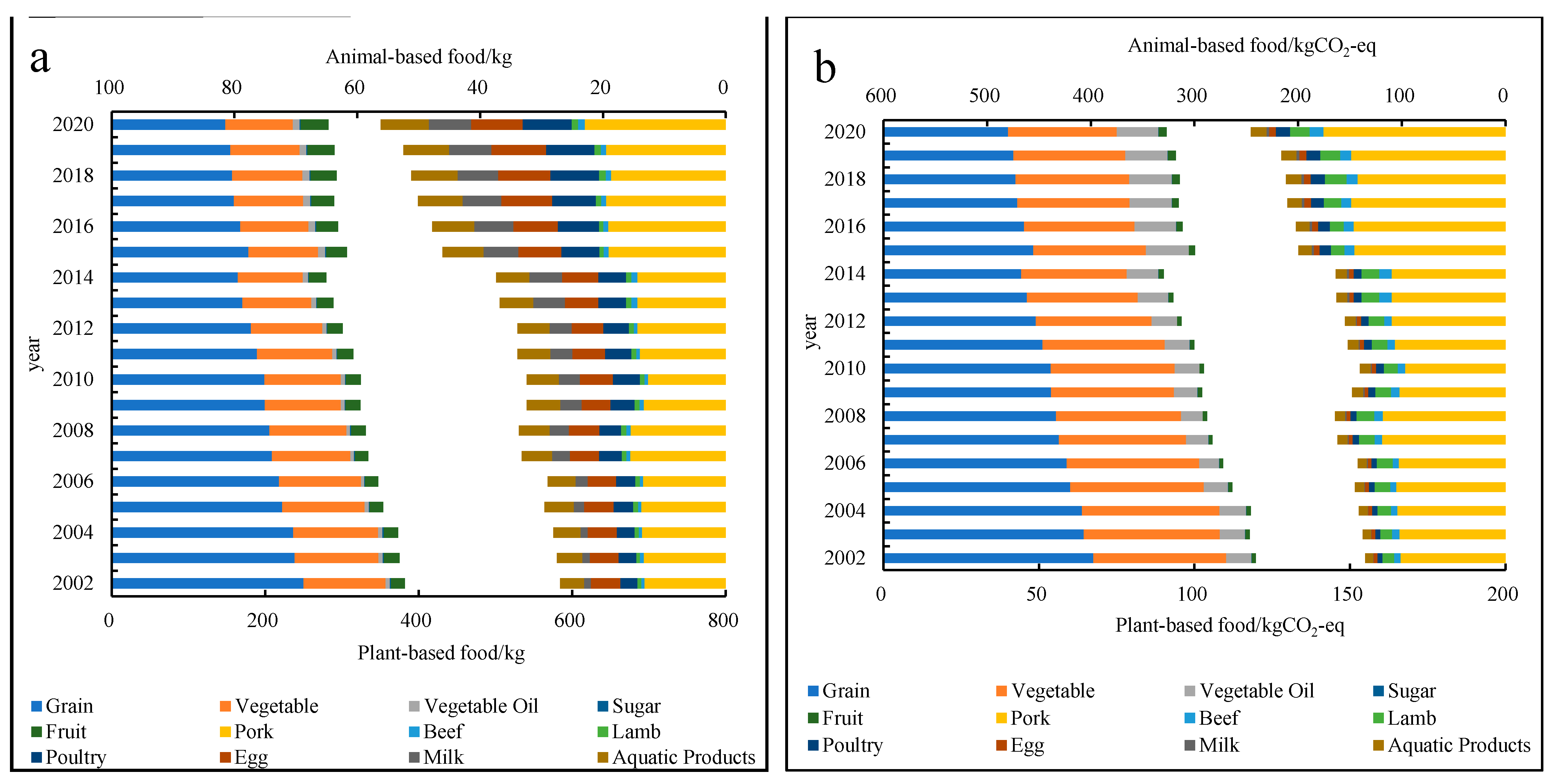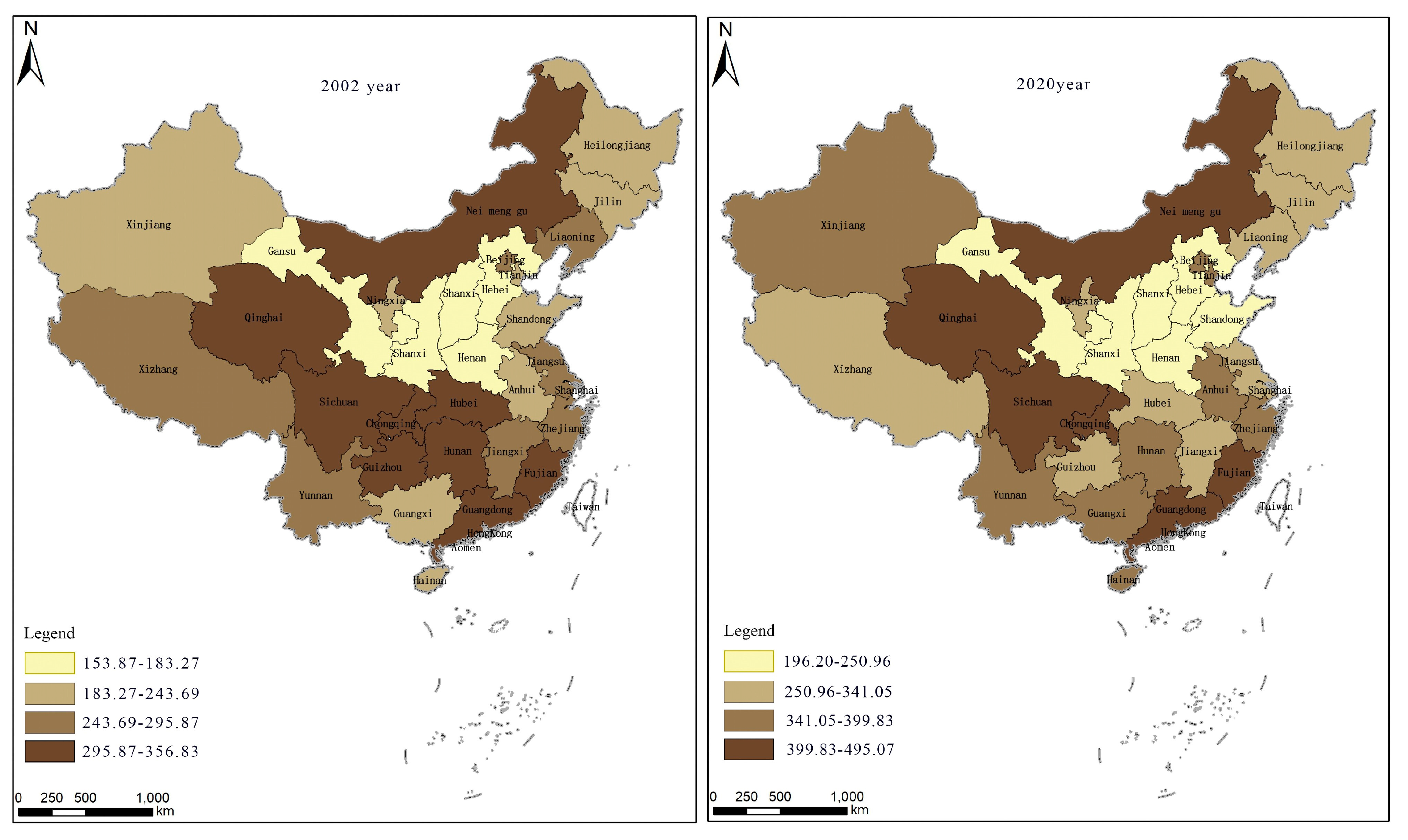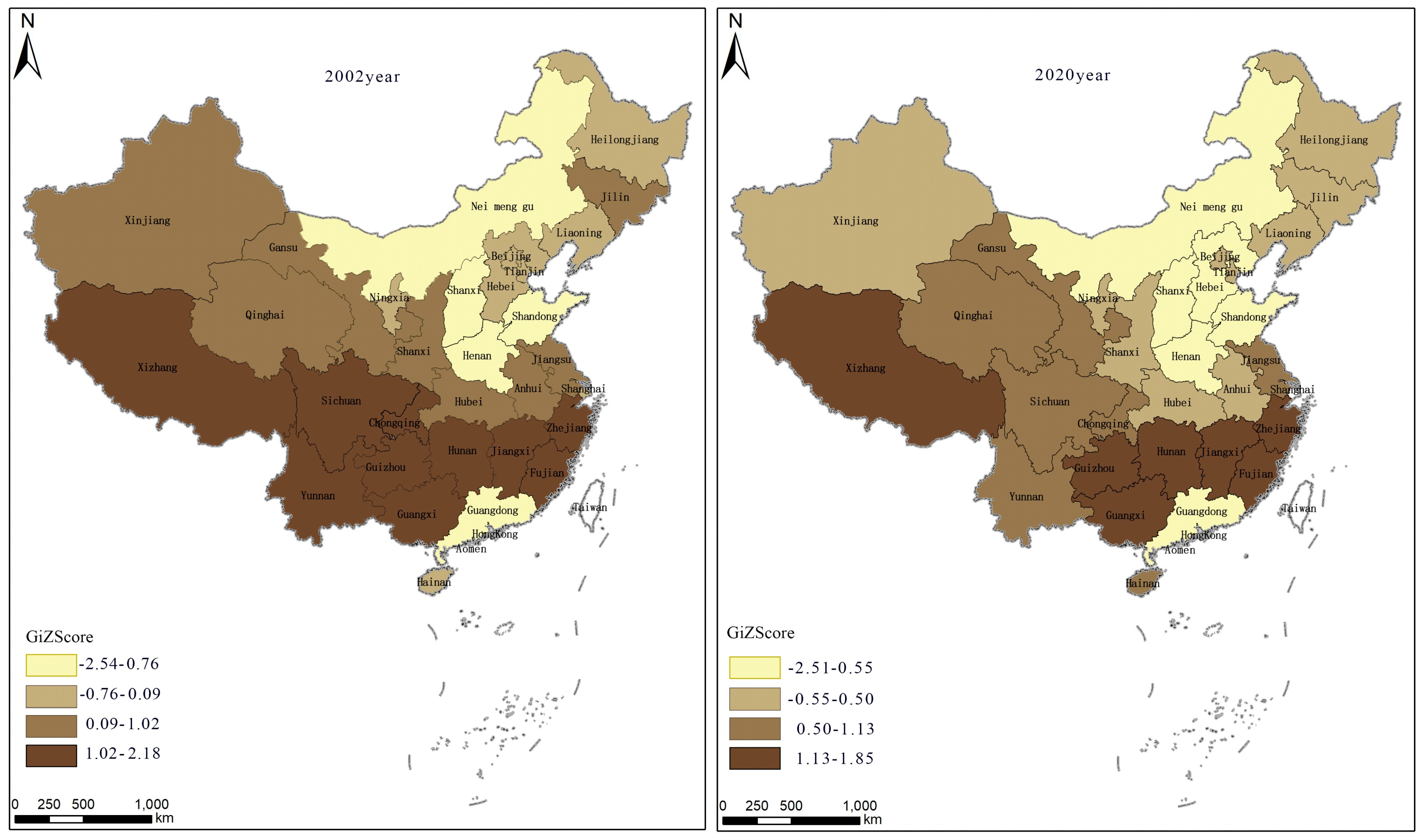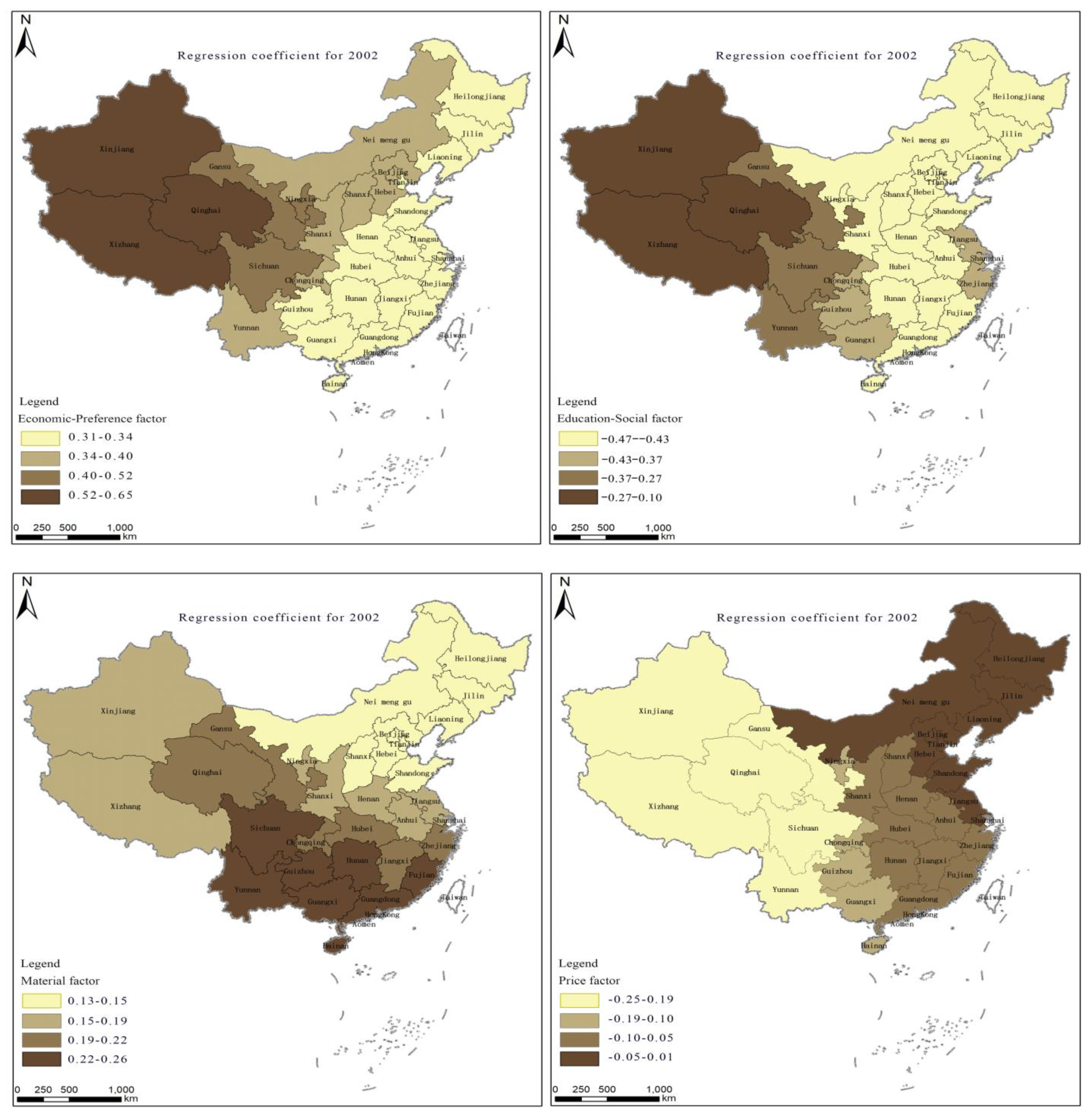Spatial–Temporal Heterogeneity and Driving Factors of Rural Residents’ Food Consumption Carbon Emissions in China—Based on an ESDA-GWR Model
Abstract
1. Introduction
2. Model Specification and Data Source
2.1. Calculation Method of Per Capita Food Consumption Carbon Emissions
2.2. Exploratory Spatial Data Analysis
2.3. Geographically Weighted Regression
2.4. Data Sources
3. Results and Discussion
3.1. Temporal Evolution Characteristics of Rural Residents’ Per Capita Food Consumption Carbon Emissions
3.2. Spatial Distribution Characteristics of Rural Residents’ Per Capita Food Consumption Carbon Emissions
3.3. Spatial Autocorrelation Analysis of Rural Residents’ Per Capita Food Consumption Carbon Emissions in China
3.4. Effective Factor Analysis of Rural Residents’ Per Capita Food Consumption Carbon Emissions in China
3.4.1. Selection of Influencing Factors
3.4.2. Spatial Differentiation of Effective Factors
Economic–Preference Factors Impact Analysis
Education–Social Factor Impact Analysis
Material Factor Impact Analysis
Price Factor Impact Analysis
3.4.3. Spatial–Temporal Evolution of Influencing Factors
4. Discussion
5. Conclusions
Author Contributions
Funding
Institutional Review Board Statement
Informed Consent Statement
Data Availability Statement
Acknowledgments
Conflicts of Interest
References
- Liu, Z.; Guan, D.B.; Wei, W.; Davis, S.J.; Ciais, P.; Bai, J.; Peng, S.S.; Zhang, Q.; Hubacek, K.; Marland, G.; et al. Reduced carbon emission estimates from fossil fuel combustion and cement production in China. Nature 2015, 524, 335–338. [Google Scholar] [CrossRef] [PubMed]
- Thompson, R.L.; Patra, P.K.; Chevallier, F.; Maksyutov, S.; Law, R.M.; Ziehn, T.; Van Der Laan-Luijkx, I.T.; Peters, W.; Ganshin, A.; Zhuravlev, R.; et al. Top–down assessment of the Asian carbon budget since the mid 1990s. Nat. Commun. 2016, 7, 10724. [Google Scholar] [CrossRef] [PubMed]
- Duan, H.B.; Zhou, S.; Jiang, K.J.; Bertram, C.; Harmsen, M.; Kriegler, E.; Vuuren, D.V.; Wang, S.Y.; Fujimori, S.; Tavoni, M.; et al. Assessing China’s efforts to pursue the 1.5 °C warming limit. Science 2021, 372, 378–385. [Google Scholar] [CrossRef] [PubMed]
- Mi, Z.; Meng, J.; Guan, D.; Shan, Y.; Song, M.; Wei, Y.M.; Liu, Z.; Hubacek, K. Chinese CO2 emission flows have reversed since the global financial crisis. Nat. Commun. 2017, 8, 1712. [Google Scholar] [CrossRef] [PubMed]
- Lemoine, F.; Unal, D. China’s Foreign Trade: A “New Normal”. China World Econ. 2017, 25, 1–21. [Google Scholar] [CrossRef]
- Su, B.; Ang, B. Multiplicative structural decomposition analysis of aggregate embodied energy and emission intensities. Energy Econ. 2017, 65, 137–147. [Google Scholar] [CrossRef]
- Mi, Z.; Meng, J.; Guan, D.; Shan, Y.; Liu, Z.; Wang, Y.; Feng, K.; Wei, Y.-M. Pattern changes in determinants of Chinese emissions. Environ. Res. Lett. 2017, 12, 074003. [Google Scholar] [CrossRef]
- Liu, L.C.; Wu, G.; Wang, J.N.; Wei, Y.M. China’s carbon emissions from urban and rural households during 1992–2007. J. Clean. Prod. 2011, 19, 1754–1762. [Google Scholar] [CrossRef]
- Feng, W.; Cai, B.; Zhang, B. A Bite of China: Food consumption and carbon emission from 1992 to 2007. China Econ. Rev. 2020, 59, 100949. [Google Scholar] [CrossRef]
- Vermeulen, S.J.; Campbell, B.M.; Ingram, J.S.I. Climate Change and Food Systems. Annu. Rev. Environ. Resour. 2012, 37, 195–222. [Google Scholar] [CrossRef]
- Notarnicola, B.; Tassielli, G.; Renzulli, P.A.; Castellani, V.; Sala, S. Environmental impacts of food consumption in Europe. J. Clean. Prod. 2017, 140, 753–765. [Google Scholar] [CrossRef]
- Xu, Y.; Geng, Y.; Gao, Z.; Xiao, S.; Zhang, C.; Zhuang, M. Accounting greenhouse gas emissions of food consumption between urban and rural residents in China: A whole production perspective. Front. Energy 2021, 15, 1–18. [Google Scholar] [CrossRef]
- Lin, J.; Hu, Y.; Cui, S.; Kang, J.; Xu, L. Carbon footprints of food production in China (1979–2009). J. Clean. Prod. 2015, 90, 97–103. [Google Scholar]
- Guo, J.L.; Xin, R.H.; Qi, Y.L.; Wen, B.Z.; Jing, Z. A Study on the Relationship between Income Change and the Water Footprint of Food Consumption in Urban China. Sustainability 2021, 13, 7076. [Google Scholar]
- Hu, Y.; Su, M.; Wang, Y.; Cui, S.; Meng, F.; Yue, W.; Liu, Y.; Xu, C.; Yang, Z. Food production in China requires intensified measures to be consistent with national and provincial environmental boundaries. Nat. Food 2020, 1, 572–582. [Google Scholar] [CrossRef]
- Pang, J.; Li, X.; Li, X.; Chen, X.; Wang, H. Research on the Relationship between Prices of Agricultural Production Factors, Food Consumption Prices, and Agricultural Carbon Emissions: Evidence from China’s Provincial Panel Data. Energies 2021, 14, 3136. [Google Scholar] [CrossRef]
- Long, Y.; Hu, R.; Yin, T.; Wang, P.; Liu, J.; Muhammad, T.; Chen, X.; Li, Y. Spatial-Temporal Footprints Assessment and Driving Mechanism of China Household Diet Based on CHNS. Foods 2021, 10, 1858. [Google Scholar] [CrossRef]
- Song, G.; Li, M.; Semakula, H.M.; Zhang, S. Food consumption and waste and the embedded carbon, water and ecological footprints of households in China. Sci. Total Environ. 2015, 529, 191–197. [Google Scholar] [CrossRef]
- He, P.H.; Li, Y.L.; Yang, S.L. Analysis of the temporal and spatial evolution characteristics of carbon emissions from food con-sumption by Chinese urban residents. China Environ. Manag. 2021, 13, 112–120. [Google Scholar]
- Li, N.Z.; Xiao, H.; Qin, G.P.; Qi, Y.; Xu, J.C.; Chen, J.Z. Research on the Driving Effect of Residents’ Food Consumption Carbon Emissions from the Perspective of Urban-rural Differentiation: An Empirical Analysis of Jiangsu Province. Soft Sci. 2021, 35, 54–59. [Google Scholar]
- Cao, Z.H.; Hao, J.M.; Xing, H.P. Analysis of the temporal and spatial evolution trend and driving mechanism of carbon emissions from food consumption of Chinese residents. Prog. Geogr. Sci. 2020, 39, 91–99. [Google Scholar] [CrossRef]
- Yan, W.; Xiao, K.W.; Fei, L. Food consumption carbon footprint of Beijing residents. Acta Ecol. Sin. 2012, 32, 1570–1577. [Google Scholar] [CrossRef][Green Version]
- Xiong, X.; Zhang, L.; Hao, Y.; Zhang, P.P.; Chang, Y.; Liu, G.Y. Urban dietary changes and linked carbon footprint in China: A case study of Beijing. J. Environ. Manag. 2020, 255, 109877. [Google Scholar] [CrossRef]
- Yang, X.; Zhang, Z.; Chen, H.; Zhao, R.; Xu, Z.; Xie, A.; Chen, Q. Assessing the Carbon Emission Driven by the Consumption of Carbohydrate-Rich Foods: The Case of China. Sustainability. 2019, 11, 1875. [Google Scholar] [CrossRef]
- Wang, L.X.; Liu, A.M.; Xin, L.J. Food Security Volume: Strategic Research on China’s Food Security and Cultivated Land Security Issues, 1st ed.; China Agriculture Press: Beijing, China, 2019; pp. 125–126. [Google Scholar]
- Tilman, D.; Clark, M. Global diets link environmental sustainability and human health. Nature 2014, 515, 518–522. [Google Scholar] [CrossRef]
- D’Adamo, I.; Morone, P.; Huisingh, D. Bioenergy: A Sustainable Shift. Energies 2021, 14, 5661. [Google Scholar] [CrossRef]
- Vacchi, M.; Siligardi, C.; Demaria, F.; Cedillo-González, E.I.; González-Sánchez, R.; Settembre-Blundo, D. Technological Sus-tainability or Sustainable Technology? A Multidimensional Vision of Sustainability in Manufacturing. Sustainability 2021, 13, 9942. [Google Scholar] [CrossRef]
- Mies, A.; Gold, S. Mapping the social dimension of the circular economy. J. Clean. Prod. 2021, 321, 128960. [Google Scholar] [CrossRef]
- He, P.; Cai, B.; Baiocchi, G.; Giovanni, B.; Zhu, L. Drivers of GHG emissions from dietary transition patterns in China: Supply versus demand options. J. Ind. Ecol. 2020, 25, 707–719. [Google Scholar] [CrossRef]
- Cao, Y.; Chai, L.; Yan, X.; Liang, Y. Drivers of the Growing Water, Carbon and Ecological Footprints of the Chinese Diet from 1961 to 2017. Int. J. Environ. Res. Public Health 2020, 17, 1803. [Google Scholar] [CrossRef]
- Zhi, J.; Gao, J.X. Comparative analysis of carbon emissions from food consumption of urban and rural residents in China. Prog. Geogr. Sci. 2009, 28, 429–434. [Google Scholar]
- Anselin, L.; Syabri, I.; Kho, Y. GeoDa: An Introduction to Spatial Data Analysis. Geogr. Anal. 2006, 38, 5–22. [Google Scholar] [CrossRef]
- Brunsdon, C.; Fotheringham, A.S.; Charlton, M.E. Geographically Weighted Regression: A Method for Exploring Spatial Nonstationarity. Geogr. Anal. 1996, 28, 281–298. [Google Scholar] [CrossRef]
- Chen, Z.; Lu, M.; Jin, Y. Regional Differences in China’s Human Capital and Educational Development: Estimation of Panel Data. World Econ. 2004, 12, 25–31. [Google Scholar]
- Rask, K.J.; Rask, N. Economic development and food production–consumption balance: A growing global challenge. Food Policy 2011, 36, 186–196. [Google Scholar] [CrossRef]
- Yang, Z.Q. How does education affect agricultural green productivity: An empirical analysis based on different forms of edu-cation in rural my country. China Soft Sci. 2019, 52–65. [Google Scholar] [CrossRef]
- Wang, W.X.; Wu, K.Y.; Liu, X.W. Analysis of Changes and Differences in Food Carbon Consumption of Urban and Rural Residents: Taking Anhui Province as an Example. Resour. Environ. Yangtze Basin 2010, 19, 1177–1184. [Google Scholar]
- Zhang, X.Y.; Li, G.; Zhang, L. Chinese consumers’ concerns about food safety: Investigation and analysis of consumers in Tianjin. China Rural. Obs. 2004, 25, 14–21. [Google Scholar]
- Lu, Y.P.; Xiao, H.F. The characteristics and trend judgment of Chinese residents’ meat consumption—Based on the double logarithmic linear expenditure model and the LA/AIDS model. J. China Agric. Univ. 2020, 25, 180–190. [Google Scholar]
- Wu, K.Y.; Wang, W.X.; Zhu, Q. Dynamic Analysis on the Changing Trend of Food Carbon Consumption of Shanghai Residents. China Popul. Resour. Environ. 2009, 19, 161–167. [Google Scholar]
- Zhang, L.L.; Sun, B.F. Research on the Food Carbon Consumption Dynamics of Urban and Rural Residents in Emerging Cit-ies—Taking Dongying City, Shandong as an Example. J. Anhui Agric. Sci. 2012, 40, 13089–13092. [Google Scholar]
- Kim, B.F.; Santo, R.E.; Scatterday, A.P.; Fry, J.P.; Synk, C.M.; Cebron, S.R.; Mekonnen, M.M.; Hoekstra, A.Y.; De Pee, S.; Bloem, M.W.; et al. Country-specific dietary shifts to mitigate climate and water crises. Glob. Environ. Chang. 2020, 62, 101926. [Google Scholar] [CrossRef]
- Xu, X.; Lan, Y. A comparative study on carbon footprints between plant- and animal-based foods in China. J. Clean. Prod. 2016, 112, 2581–2592. [Google Scholar] [CrossRef]
- Lacour, C.; Seconda, L.; Allès, B.; Hercberg, S.; Langevin, B.; Pointereau, P.; Lairon, D.; Baudry, J.; Kesse-Guyot, E. Environmental Impacts of Plant-Based Diets: How Does Organic Food Consumption Contribute to Environmental Sustain-ability? Front. Nutr. 2018, 5, 1–13. [Google Scholar] [CrossRef] [PubMed]
- Bao, G.H.; Liu, W.Q.; Cui, Y.S.; Liu, D.M.; Liu, X.F. Sustainable Development of Food Consumption of Rural Residents. Bus. Res. 2003, 81–83. [Google Scholar] [CrossRef]
- Garnett, T. Where are the best opportunities for reducing greenhouse gas emissions in the food system (including the food chain)? Food Policy 2011, 36, S23–S32. [Google Scholar] [CrossRef]
- Yan, Z.C.; Sheng, H.; Wang, H.N.; Yu, Y.; Xu, L.L. Food C, N and P consumption dynamics of residents in Xiamen’s rapid urbanization. Environ. Sci. Technol. 2012, 35, 479–486. [Google Scholar]
- He, P.; Baiocchi, G.; Hubacek, K.; Feng, K.; Yu, Y. The environmental impacts of rapidly changing diets and their nutritional quality in China. Nat. Sustain. 2018, 1, 122–127. [Google Scholar] [CrossRef]
- Chen, R.; Ding, X.H.; Min, W.F. Research on the Contribution of Education to Green GDP. Educ. Res. 2019, 40, 133–141. [Google Scholar]
- Li, Y.C.; Jiang, B.; Zhang, M.; Huang, Z.J.; Deng, Q.; Zhou, M.G.; Zhao, Z.P.; Wang, Y.F.; Wang, L.M. Vegetable and Fruit Consumption among Chinese Adults and Associated Factors: A Nationally Representative Study of 170,847 Adults. Biomed. Environ. Sci. 2017, 30, 863–874. [Google Scholar]
- Xu, X.K.; Han, L.Y. How do consumption patterns affect household carbon emissions?—Micro-evidence from Chinese urban households. Southeast Acad. 2017, 154–163. [Google Scholar] [CrossRef]
- Singh, G.M.; Micha, R.; Khatibzadeh, S.; Shi, P.L.; Lim, S.; Andrews, K.G.; Engell, R.E.; Ezzati, M.; Mozaffarian, D. Global, Regional, and National Consumption of Sugar-Sweetened Beverages, Fruit Juices, and Milk: A Systematic Assessment of Beverage Intake in 187 Countries. PLoS ONE 2015, 10, 0124845. [Google Scholar]





| Food Type | Grain | Vegetable | Vegetable Oil | Sugar | Fruit | Pork |
| Coefficient | 0.27 | 0.40 | 1.48 | 0.08 | 0.07 | 7.64 |
| Food Type | Beef | Lamb | Poultry | Egg | Milk | Aquatic Products |
| Coefficient | 12.04 | 18.86 | 1.71 | 0.78 | 0.36 | 1.94 |
| Year | Moran’s I Value | Z-Value | p-Value |
|---|---|---|---|
| 2002 | 0.266 | 2.717 | 0.007 |
| 2003 | 0.261 | 2.681 | 0.007 |
| 2004 | 0.241 | 2.497 | 0.013 |
| 2005 | 0.114 | 1.398 | 0.162 |
| 2006 | 0.159 | 1.755 | 0.079 |
| 2007 | 0.259 | 3.014 | 0.003 |
| 2008 | 0.290 | 2.934 | 0.003 |
| 2009 | 0.228 | 2.374 | 0.018 |
| 2010 | 0.175 | 1.893 | 0.058 |
| 2011 | 0.155 | 1.709 | 0.088 |
| 2012 | 0.221 | 2.374 | 0.018 |
| 2013 | 0.245 | 2.613 | 0.009 |
| 2014 | 0.227 | 2.422 | 0.015 |
| 2015 | 0.278 | 2.860 | 0.004 |
| 2016 | 0.307 | 3.266 | 0.001 |
| 2017 | 0.273 | 2.942 | 0.003 |
| 2018 | 0.219 | 2.429 | 0.015 |
| 2019 | 0.194 | 2.073 | 0.038 |
| 2020 | 0.170 | 1.855 | 0.064 |
| Driving Factors | Variable System | Variable Interpretation |
|---|---|---|
| Economic–preference factor | Per capita disposable income | Reflects the income level of rural residents |
| Per capita GDP | Reflects the level of economic development in rural areas | |
| Food consumption expenditure | Characterizes the cash input of rural residents in food consumption | |
| Dietary structure | Represents the food consumption preferences of rural residents | |
| Education–social factor | Per capita average years of education | Reflects the cultural quality of rural residents |
| Engel coefficient | Reflects the diversity of consumption choices of rural residents | |
| Material factor | Consumer price index (last year = 100) | Characterizes price fluctuations in rural commodity markets |
| Food consumption | Refers to the amount of food consumed by rural residents | |
| Price factor | Food retail price index (last year = 100) | Reflects the selling price of food in rural areas |
| Parameters | 2002 Year | 2020 Year |
|---|---|---|
| Neighbors | 29 | 29 |
| Residual squares | 17,872.616 | 41,339.173 |
| Effective number | 10.930 | 11.154 |
| Sigam | 29.841 | 45.640 |
| AICc | 315.677 | 342.530 |
| R square | 0.833 | 0.802 |
| Adjusted R square | 0.750 | 0.700 |
Publisher’s Note: MDPI stays neutral with regard to jurisdictional claims in published maps and institutional affiliations. |
© 2021 by the authors. Licensee MDPI, Basel, Switzerland. This article is an open access article distributed under the terms and conditions of the Creative Commons Attribution (CC BY) license (https://creativecommons.org/licenses/by/4.0/).
Share and Cite
Qin, S.; Chen, H.; Wang, H. Spatial–Temporal Heterogeneity and Driving Factors of Rural Residents’ Food Consumption Carbon Emissions in China—Based on an ESDA-GWR Model. Sustainability 2021, 13, 12419. https://doi.org/10.3390/su132212419
Qin S, Chen H, Wang H. Spatial–Temporal Heterogeneity and Driving Factors of Rural Residents’ Food Consumption Carbon Emissions in China—Based on an ESDA-GWR Model. Sustainability. 2021; 13(22):12419. https://doi.org/10.3390/su132212419
Chicago/Turabian StyleQin, Shuai, Hong Chen, and Haokun Wang. 2021. "Spatial–Temporal Heterogeneity and Driving Factors of Rural Residents’ Food Consumption Carbon Emissions in China—Based on an ESDA-GWR Model" Sustainability 13, no. 22: 12419. https://doi.org/10.3390/su132212419
APA StyleQin, S., Chen, H., & Wang, H. (2021). Spatial–Temporal Heterogeneity and Driving Factors of Rural Residents’ Food Consumption Carbon Emissions in China—Based on an ESDA-GWR Model. Sustainability, 13(22), 12419. https://doi.org/10.3390/su132212419






